
Bct Terms 1 3
- 1. BCT Section 1.3 & 1.4 Terms Input & Output Devices, Software & Computer Care 1. Word Processing Business Applications Programs that allows you to create, edit, and print text documents. 2. Spreadsheet Numbered Rows and Lettered Columns 3. Database Business Software that lets you set up an electronic filing systems. Enter text and numbers Find, search, and printer info in different ways 4. Utility Help you perform housekeeping chores complete specialized tasks related to managing the computer’s resources, file management, and so on. 5. Application Software Programs that work with the OS software to help you use your computer to do specific types of work. 6. System Software A group of programs that coordinate & control the resources and operations of a computer. Enables components of the computer to communicate. 7. Integrated Software Combine several software applications into one program. 8. Desktop Publishing Uses both pictures and words to give you the ability to create documents. 9. Communications Works with your modems or network hardware and allows your computer to communicate with other computers. 10. Multimedia Combines text, graphics, animation, video, and audio. 11. Input Devices Hardware that allows you to communicate with your computer. 12. Output Devices Hardware that allows your computer to communicate with the user. 13. Magnetic Storage Devices Use oxide-coated plastic storage media called mylar. As the disk rotates in the computer, an electromagnetic read/write head stores or retrieves data in circles called tracks. 14. Hard Disk Drive Used to store data inside of the computer. Magnetic platter that holds a large amount of information in a form the computer can understand. Accessing data is faster.
- 2. 15. Floppy Disk Flat circles of iron oxide-coated plastic enclosed in a hard plastic case. Most are 3 ½ inches and have a capacity to hold 1.44 MB or more of data. 16. Zip Disk Capable of storing tremendous amounts of information, they are only the size of a 3 inch disk but can hold as much as 1 gigabyte of data. 17. Magnetic Tape Drives Used for making backup copies of large volumes of data. Very slow. 18. Optical Discs Use laser technology to read and write data on platters. 19. CD-ROM Compact Disk Read-Only Memory) can store up to 800MB of data. 20. DVD (Digital Video Disk) is the size of a regular CD and can be played in a regular CD or in a DVD movie player. Storage from 4 to 17 GB. 21. Operating System Provide an interface between the user or application program and the computer hardware. 22. Graphical User Interface Graphical symbols (icons) represent files, disks, programs, and other objects. 23. Proper Computer Care No food & drink Avoid dusty locations Use a surge protector Keep magnets Away Do not block vents on the CPU Avoid bright sunny locations Do not move the computer while it is in use Always exit programs properly Use a virus check program on a regular basis 24. Proper Diskette Care Do not remove from drives while drive is running or light is on. Avoid contact with magnets & electromagnetic fields. Keep disks stored in a clean, cool and dry place with a protective cover.
- 3. Keep protective metal slider in place. Use a virus check program on a regular basis. Avoid hot & cold locations. Make a Back-up copy of your programs and files. 25. Proper CD ROM Care Keep CDs stored in a clean, cool and dry place with a protective cover. Avoid touching the back side of the CD; to avoid scratches. Avoid hot and cold locations. Make a back-up copy of your programs and files. Insert into CD ROM Drive properly; label facing up. Only write on CD’s with a CD Marking Pen on a label or the correct side of the CD 26. Proper Printer Care Avoid cold, hot, and dusty locations. Always use the correct ink or toner replacement. Always have the proper printer cable connected to your computer. Never pull paper out of a printer in motion. Do not turn off the printer while printing. Read the instruction manual before operating a printer. Always use the proper type of paper in your printer. 27. How to Maintain your Start a Log of information on your System Computer System Serial numbers, Vendor support telephone numbers User IDs Date and vendor for each equipment and software purchase.
- 4. List of Error Messages Periodically review disk directories and delete unneeded files. Make sure all plug-ins are secure at all times. Turn off the power and disconnect the equipment form the power source before you open the inside of you computer. Keep surrounding area dirt and dust free. Back up files and data regularly. Periodically defragment your hard disk. Protect your system from computer viruses Learn to use system diagnostic programs 28. Ergonomics The science of designing equipment for a comfortable and safe working environment.